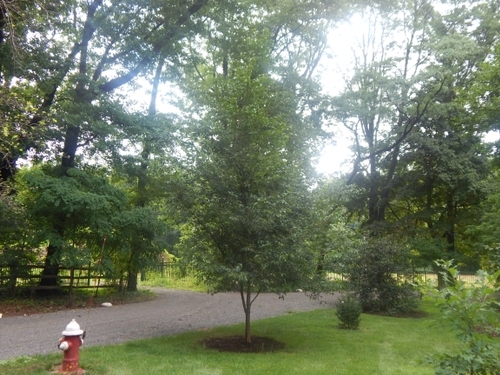Scientific Name: Catalpa Speciosa
Catalpas have white flowers with a bit of yellow, and purple on the inside, which make them quite popular with bees [1]. They produce a fruit-shaped pod that contains numerous seeds with white tufts of hair at each end. Catalpas can be found in the forests of southern Illinois, Indiana, and western Tennessee and Arkansas. The plant was first cultivated in the 1754, at which time the wood from the tree was used for fence posts and railroad ties because of resistance to rot and quick growth rate.
[1]https://www.ndsu.edu/pubweb/chiwonlee/plsc211/student%20papers/articles05/hanson,%20derek/Lab%20Report%204/dhanson.htm
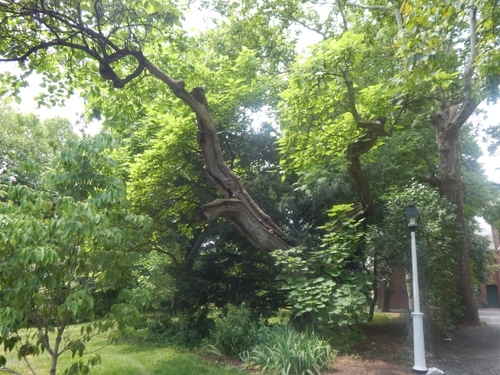
Scientific Name: Magnolia stellate
Circumference: at 4.5 ft from the ground - 13 ft or 156 inches
Height: 55 ft
Averagecrown spread: 44ft
Points using the National Forest System: 211
Condition: Very Good
Noteworthy Features: The largest Star Magnolia reported in Union County and in the state.
The Star Magnolia is a shrub-like tree that produces a cluster of white star shaped petals with a touch of pink [1]. The Star Magnolia is native to the mountains near Nagoya, Japan.
[1] https://naturewalk.yale.edu/trees/magnoliaceae/
magnolia-stellata/star-magnolia-40
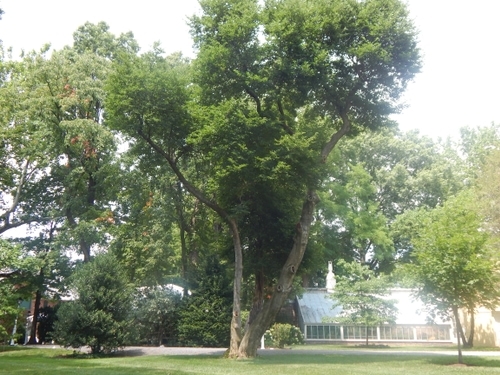
Scientific Name: Ginkgo Biloba
Ginkgo, otherwise known as the ginko tree or the maidenhair tree, is the only living species from the Ginkgophya family [1]. It is considered an endangered species. Ginkgo is easily identifiable by its fan-shaped leaves. It can be traced back as far as 200 million years ago. It is theorized that the fruit produced by female ginkgos attracted dinosaurs.
[1] https://naturewalk.yale.edu/trees/ginkgoaceae/ginkgo-biloba/ginkgo-41
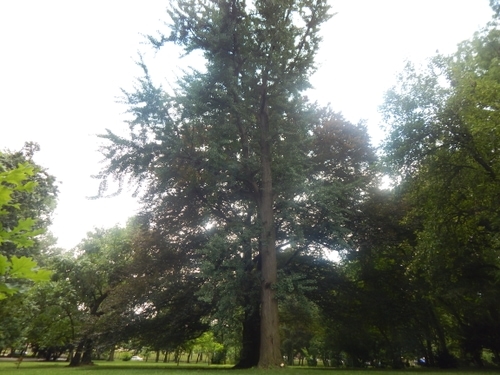
Scientific Name: Pyrus communis "Seckel"
Circumference: at 4.5 ft from ground - 9ft 6 inches or 114 inches
Height: 35 ft
Average crown spread: 33ft
Points using the National Forest System: 149
Condition: Very Good
Noteworthy features: This is the largest Seckel Pear tree reported in Union County and in the state
Seckel Pear trees are often referred as sugar pears for their unique sweet taste [1] and are considered the only true American pear variety. There are conflicting reports about the origin of the Seckel pears. One report states that the pears were found growing in Pennsylvania, while the other argues that the pear seeds were left behind by German immigrants that were traveling westward in the 1700s – 1800s. Today the pears can be found in the Pacific Northwest (Idaho, Oregon, Washington, and the Canadian Province of British Columbia).
[1]http://www.specialtyproduce.com/produce/Seckel_Pears_6582.php
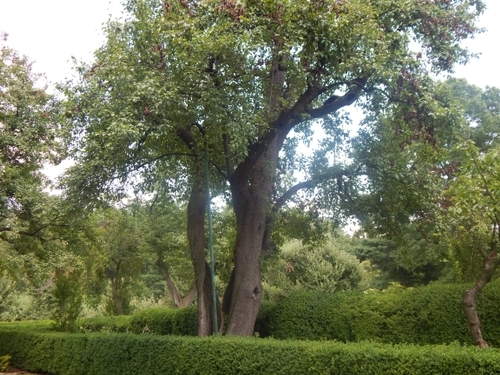
Scientific Name: Pyrus communis "Williams”
Circumference: 4.5 ft from ground - 7 ft 10 inches or 94 inches
Height: 33ft
Average Crown Spread: 36 ft
Point using the National Forest System: 136
Condition: Very Good
Noteworthy features: This tree is the largest Bartlett Pear reported in Union County and in the state.
Bartlett pears are one of the few pears that do not change color when their ripe. They are easily identifiable by the bright yellow color when ready to eat and their sweet taste [1]. Bartlett pears originate from England, where they were commonly known as “Williams pear”. They were later imported into Massachusetts by the end of the 18th century and planted on the Brewer Estate. The Brewer estate was later acquired by Enoch Bartlett and the pear was introduced under his name. It wasn’t until 25 years later, that the Bartlett and Williams pears were the same. Today Bartlett pears account for 95% of the commercial pears found in supermarkets.
[1] https://usapears.org/bartlett/
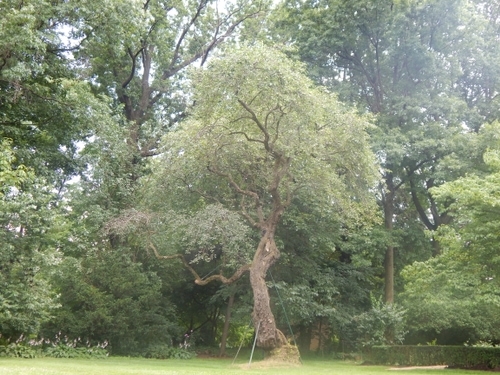
Scientific Name: Aesculus hippocastanum
Circumference: at 4.5 from ground - 10 ft 11 inches or 131 inches
Height: 49 ft
Average crown spread: 57 ft
Points using the National Forest System: 180
Condition: Very Good
Noteworthy features: This tree is the largest Horse Chestnut reported in Union County and in the state.
It is native to Greece and Albania. At maturity the Horse Chestnut can reach a height of 80 ft. with a spread of 40 ft. wide [1]. The Chestnut tree produces a brown poisonous seed enclosed by a green capsule also known as a conker. Normally, conkers appear in September and fall onto the ground as they ripen. Although the conkers are poisonous for most animals, deer are able to digest them safely [2].
[1] http://edis.ifas.ufl.edu/st061
[2] https://naturewalk.yale.edu/trees/sapindaceae/aesculus-hippocastanum/horse-chestnut-9
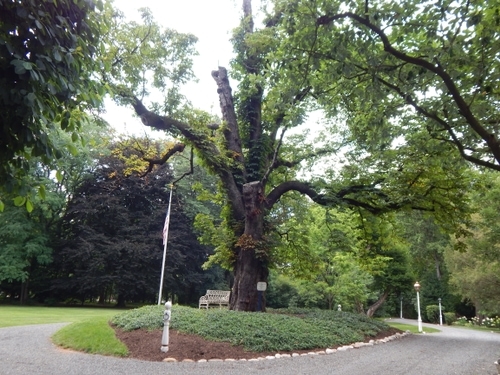
Scientific Name: Magnolia virginiana
Sweetbay Magnolia otherwise known as: Swamp Magnolia or Sweetbay. It is indigenous to the coastal areas of the Atlantic of the United States [1]. Sweetabay can reach a height of 15 to 20 ft tall in northern areas of the United States, in southern states it can grow double the size [2]. During the months of May to June the Sweetbay Magnolia produces white flowers that have a distinct lemon odor [3].
[1]https://hvp.osu.edu/pocketgardener/source/description/ma_niana.html
[2] https://plants.ces.ncsu.edu/plants/all/magnolia-virginiana/
[3] http://www.hort.uconn.edu/plants/detail.php?pid=279
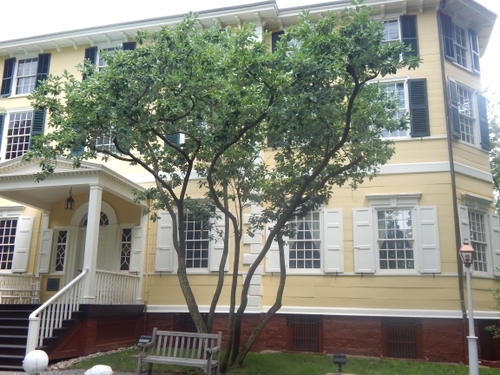
Scientific Name: Taxus X Media, Anglop Yew
Circumference: 4.5 ft from the ground - 10 ft 4 inches or 124 inches
Height: 48 ft
Average crown spread: 42 ft
Points using the National Forest System: 172
Condition: Very Good
Noteworthy features: This tree is the largest reported Hickii Yew in Union County and in the state.
Hicksii Yew is a cross-breed of English Yew and Japaneese Yew [1]. The Hicksii Yew comes in various in various shapes and sizes such as large trees, small bushes, or even tall hedges. It produces needle-like leaves that have a green color on the upper side and a light green on the underside.
[1] https://naturewalk.yale.edu/trees/taxaceae/hybrid-taxus-baccata-and-taxus-cuspidata/anglojap-yew-55
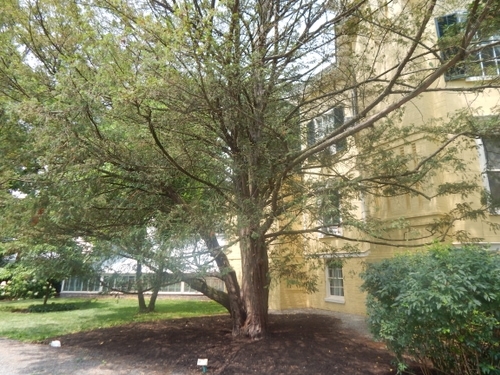
Scientific Name: Fagus sylvatica
Circumference: 4.5 ft from ground - 16 ft 7 inches or 199 inches
Height: 107 ft
Average crown spread: 107 ft
Points using the National Forest System: 306
Condition: Very Good
Noteworthy features: This tree is the largest European Beech reported in Union County and 4th largest reported in the state.
At maturity, the European Beech can reach a height of 60 ft. tall with a spread of 40 ft. [1].During the months of April and May, the European Beech produces flowers that can either be male or female. Its fruits ripen between September and October. Each fruit contains a three-sided pointed nut, which is quickly gathered by squirrels and other animals in the area.
[1]https://hvp.osu.edu/pocketgardener/source/description/fa_atica.html
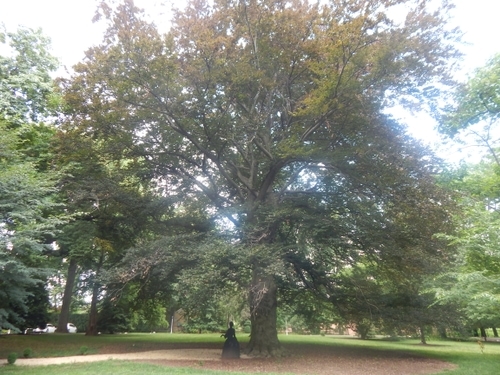
Scientific Name: Aesculus flava
Circumference: at 4.5 from ground : 12 ft 2 inches or 146
Height: 87 ft
Average crown spread: 53.5 ft
Points using the National Forest System: 223
Condition: Very Good
Age: 232 years old
Noteworthy features: This is the largest Yellow Buckeye reported in Union County and the largest reported in the state.
The Yellow Buckeye is easily distinguishable for its large yellow flowers and its palm-shaped leaves. On average, the Yellow Buckeye can grow between 60 to 80 ft. tall; however, some Buckeyes have reached more than 100 ft. tall [1]. Through September and October, its fruit mature. The fruit contains 1 to 3 seeds, which contain toxins that are absorbed poorly by humans. Although the seeds rarely harm individuals, they tend to be deadly for animals. Native American hunting tribes placed the seeds into small bodies of water (river and lakes) to capture fish [2].
[1] http://www.hort.uconn.edu/plants/detail.php?pid=36
[2] https://mlbs.virginia.edu/organism/aesculus_flava
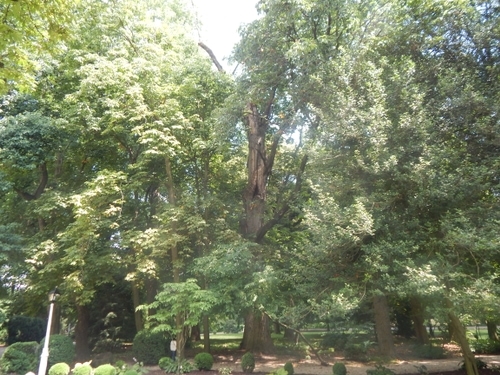
Scientific Name: Platanus occidentalis
The American Sycamore, also known as the "Sycamore", or "Eastern Sycamore". It is indigenous to Iowa and surrounding areas, and it can reach a height of 75 to 100 ft.[1] It can reach its maximum height if it is near a body of water such as streams or rivers [1]. Sycamore is a monoecious; it is able to produce male and female flowers on the same tree. Although it is difficult to see its flowers they usually start appearing in May, and its fruit ripen in September or October.
[1] https://plants.ces.ncsu.edu/plants/all/plataus-occidentalis/
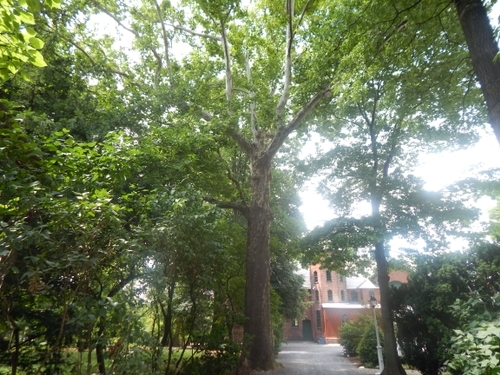
Scientific Name: Gymnocladus dioicus
Circumference: at 4.5 ft from ground - 12 ft 2 inches or 106 inches
Height: 90 ft
Average crown spread: 58 ft
Points using the National Forest System: 196
Condition: Very Good
Age: 101
Noteworthy features: This tree is the largest Kentucky Coffee reported in Union County and in the state.
The Kentucky Coffee can survive in various environments and soils[1] . However, it does well in environments that have full sunlight and most rich soils. At maturity, the Kentucky Coffee can reach a height of 60 to 75 ft. in height and a spread of 40 to 50 ft. That is as tall as the Hollywood sign!
[1] http://www.uky.edu/hort/Kentucky-Coffeetree
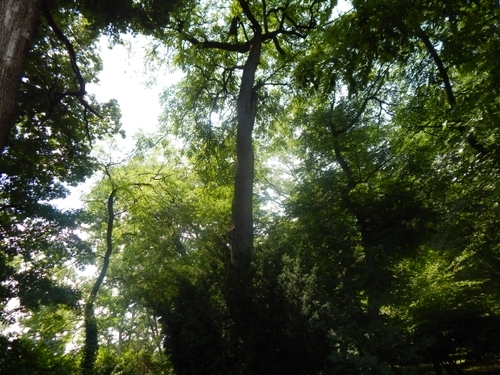
Scientific Name: Ilex opaca
The American Holly is native to Northern America from Eastern Massachusetts through Mid-Florida,and western parts of Texas [1]. Holly can grow in a variety of environments such as wetlands, dry-land and sandy medium. It can reach a height of 35 to 50 feet.
[1] http://www.uky.edu/hort/American-Holly
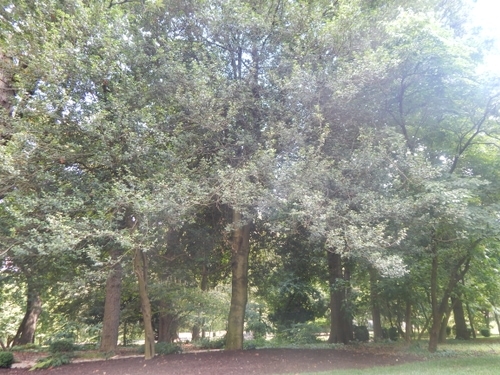
Scientific Name: Crategus Phaenopyrum
The Washington Hawthorn is the largest Hawthorn from the Hawthorn family [1]. The plant was introduced to the United States 1700's. It can grow between 20 to 35 ft tall with a spread of
20 to 25 ft. [2] During blooming season, the Washington Hawthorn produces white flowers that contain a red pome [3].
[1]https://www.bellarmine.edu/faculty/drobinson/WashingtonHawthorn.asp
[2]http://edis.ifas.ufl.edu/st212
[3]http://www.hort.uconn.edu/plants/detail.php?pid=147
